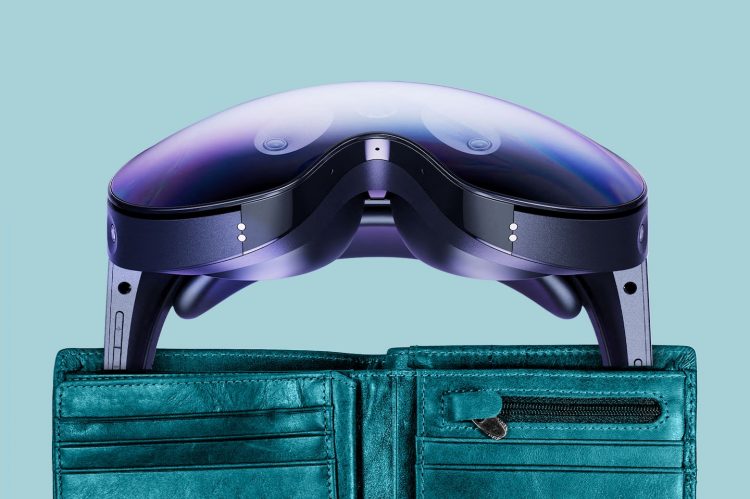If there were any doubts that Meta’s virtual reality experimentation would prioritize workplace productivity over games, they vanished Tuesday, when the company revealed the price of its latest VR headset, the Quest Pro: $1,499.
No, that’s not a typo. For nearly the same price as one Quest Pro, consumers could purchase a PlayStation 5, Xbox Series X and a Quest 2 VR headset. That’s three high-end gaming platforms. A gamer could buy four of the newest Nintendo Switch OLED models. Many gaming PCs also cost less than the Quest Pro.
Forget all the boosted specs, the increased resolution, the new features, or any other changes from the Quest 2. As impressive as they may be, they’re all functionally irrelevant. There’s only one stat that matters for the Quest Pro if you use it for entertainment purposes, and it’s the price.
The announcement of the Quest Pro’s price tag, made during Oct. 11′s Meta Connect event, serves as a hard pivot from its consumer-friendly pricing of the Quest 2, the previous version of Meta’s VR set that debuted in 2020. The Quest 2 first retailed at $299 for the cheapest model, and $399 for one with expanded storage. Meta raised the price tag on both versions by $100 earlier this year, citing supply chain and production issues.
The rationale behind the pricing of the relatively affordable Quest 2 was fairly simple: get more people on VR. With more users, software publishers would have more incentive to develop games and other apps, which have been spare to date, knowing that there was a larger potential consumer base on the way.
That logic goes out the window when you slap a $1,500 price tag on a new platform. Instead, it’s replaced by questions. The first of which is: Who is this for? Because it is absolutely not for gamers.
Quest 2 originally cost $299, which was an amazing price even for today. Why would people pay $1500 for a “pro” device when the software still looks like Wii U era https://t.co/ezVWcfDNYa
— Dan Nguyen is a BOO-in (@dancow) October 11, 2022
VR has suffered for years from the lack of the proverbial “killer app,” that one game that makes consumers feel they need to purchase a particular gaming platform so they don’t miss out. Game inventory on the whole has been thin for VR, providing few reasons for gamers to splurge on a headset. And that was before the Quest 2 price tag shot up from $299.
At $1,500, what, exactly, is going to provide that motivation? The bar is literally five times higher now.
Whatever the motivation is, it does not appear to be games — at least not based on those showcased at Meta Connect, of which there were a mere handful. “Iron Man VR,” a game previously available on PS VR, is coming to the Quest store. There was a spare cinematic teaser for a new IP called “Behemoth” by Skydance, the developer behind “The Walking Dead: Saints and Sinners,” which also touted new content. “Population: One,” the VR battle royale title, is getting a sandbox mode allowing players to create their own maps. Even the addition of Microsoft’s cloud-streaming service adds little excitement. Who wants to play games in 2D while wearing a headset?
None of that is enticing enough to spur the adoption of VR at the price tag of $1,500. There is exponentially more game inventory, with better experiences, available on immersive next-gen consoles for a third of the price. Oh, and by the way, a new VR headset from PlayStation, the PS VR 2, is coming soon. (The price for the PS VR2 has not yet been announced; the original PS VR device launched at $399).
So again, who is going to buy the Meta Quest Pro?
My guess: Meta is bypassing individual consumers to focus on companies instead. If you think of the Quest Pro through the lens of a work productivity device, one that is purchased by corporations for its employees — pre-packed with productivity and collaborative software — instead of as an entertainment platform, the price becomes a little easier to understand.
“This is the first version of the work VR device line that we’re shipping,” Meta CEO Mark Zuckerberg told The Verge Tuesday. “Basically, this is a step toward all 200 million of those people who get new PCs every year starting to instead do some of the work in VR.”
Meta is positioning the construction of the metaverse around corporate functionality. So what will happen to the other elements of Meta’s VR ecosystem if it’s mainly framing the Quest Pro as a new-age office computer? Meta also touted the health and fitness applications available on the Quest. Are people going to sink $1,500 into a headset, alongside a monthly subscription to apps like Supernatural? Or are they just going to buy a Peloton instead of sweating all over their headset/metaverse meeting room?
Setting aside whether Meta can successfully construct the metaverse, the impact of its decision to significantly increase the price point for its premier VR headset will be worth monitoring in the months ahead. Previously, it seemed as though Meta was throwing open wide the doors to its virtual worlds by enticing consumers with access to VR for a few hundred dollars. It felt like VR could finally achieve the kind of critical mass that would entice both new users and new developers to create for the platform.
Now, the invitation — carrying a cover charge of $1,499 — seems a lot less enticing. And if consumers shy away, will software makers follow suit?
Source by www.washingtonpost.com


























